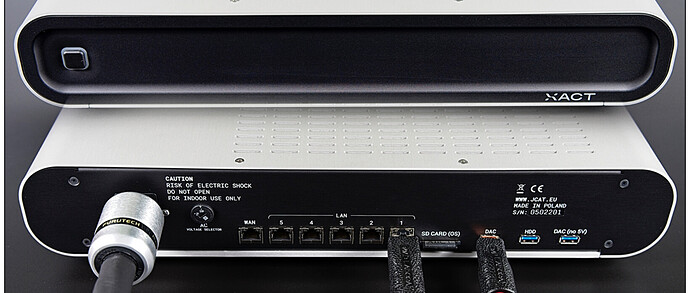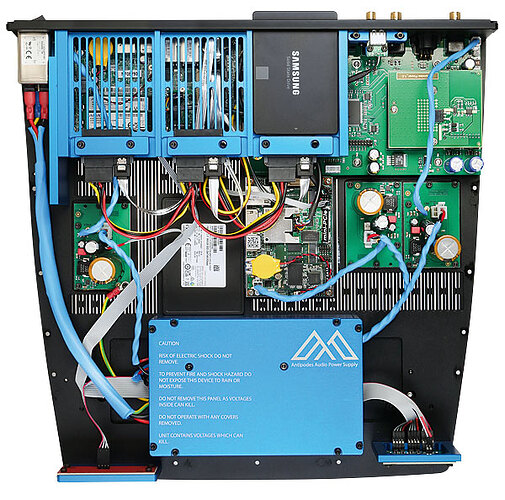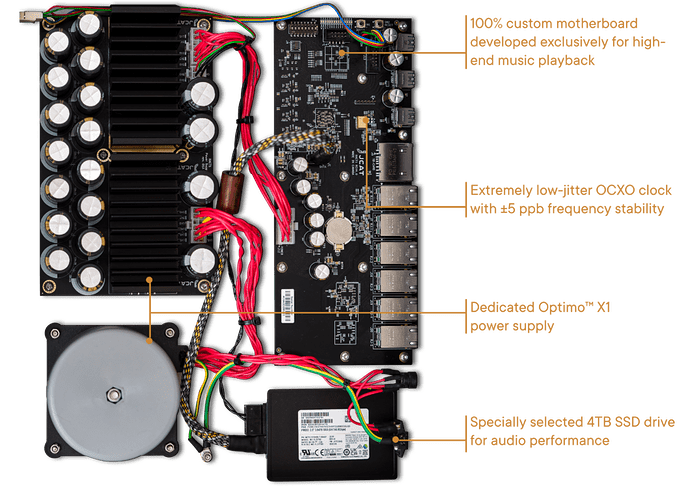Good point. Although being a network transport + a music server + a router / switch, if only 25% of users can run it, and it lacks ROON, that’s certainly not the level of flexibility we’re accustomed to here.
I agree totally but just thought it worth pointing out that their server supports UPnP, so one isn’t limited to controlling it with JPlay for iOS. I’m not sure I’d expect much of a loss in fidelity if another control app was used. Bottom line though, it’s a niche solution that won’t appeal to most consumers in this space. I suspect it’s more about them making a statement about what is possible to achieve using their hardware components and their software.
I should have posted here instead of under JPLAY on Antipodes:
It’s interesting that you mention the music SSD. Apologies if I’m repeating myself—this may have come up in a different thread—but in addition to being highly recommended by Antipodes for music file storage, JCAT also utilizes an “industrial-grade SSD, carefully selected for its distinctive sound qualities”—specifically, the PM893 SSD available in 4GB or 8GB capacities. Coincidence?
To lift performance further, in their latest flagship server, the JCAT XACT S1, the music SSD is connected to the motherboard with a special JCAT made 40 cm directional, cryo-treated SATA cable made with copper/silver conductors.
While in Oladra you can choose the PM893 for storing music files (the 3 slots on top in the image), the Oladra server already comes with a pre-installed PM893 dedicated to the operating system (in center, based on this [image ]
edit: a 480 Gb SSD connected to the serverboard for its OS, while the player board OS seems installed on a M.2 drive.
(Antipodes Audio Oladra Network Audio Library | Hi-Fi News) from Sept '23), whereas the XACT S1 runs its OS from an industrial SD card (very recent image ).
Just consider that Taiko recommends for their new Olympus server to remove all internal storage for SQ reasons. In this context I am wondering if it makes sense to offer internal storage as a default solution. So it would be be very nice if streamer manufacturers offer their streamers without internal storage as default version.
This would be a real advantage:
1.) Internal storage seems to degrade SQ
2.) Some people (like me) do streaming from streaming services only and don’t need internal storage.
3.) The basic price of the streamer without storage is lower, that is good for competition.
1.) True, internal storage seems to degrade sound quality in a €67,000 Olympus server. To hear improvement without local storage, one also needs a Taiko battery PSU, a custom Taiko router, a Taiko switch connected via DAC cable to a Taiko network card. And instead of USB, it uses XDMI—a direct PCIe connection between the CPU/memory of the server and the I2S conversion stage just before the DAC chip (€15.400 bundle price).
It also seems that with Olympus upsampling and higher-resolution music are no longer relevant.
2.)
Some people (myself included) only stream music from streaming services and don’t need internal storage.
So, if it’s not in use, how could it impact sound quality?
3.)
The base price of the streamer without storage is lower
, which is exactly what Antipodes offers today. You can add up to three SSDs of your choice if needed.
Your comments make me wonder—are you, or were you, an Antipodes server user? When comparing systems, it’s crucial to keep things “apples to apples.” As exciting as certain setups may sound, it’s important to avoid generalizations. Both the devices themselves and factors like power supply, network quality, and the type of files—whether streamed or stored locally—contribute to the overall sound quality.
In 2024, audiophiles have more options than ever to tailor their setups based on budget and preferences—whether that means tuning for optimal performance with local files, streaming, or even switching between the two as desired. However, it’s not as black and white as it may seem.
At least in a Taiko environment there is a a gain in SQ when internal storage is removed even when not used. As you mentioned XACT S1 this server was offered first without internal storage at a price of 10k. This was the right option for all users.
I’m just as intrigued as you are! However, it seems to follow the same logic as removing a switch, cable, power supply, or router. We’ve learned that both power (draw) and network significantly affect a servers sound quality, perhaps even more than we initially realized. I think your point about eliminating local storage touches on this idea, and I really appreciate your perspective!
I am an advocate for offering all servers (streamers) without any storage as default. If there is the possibility to add internal storage the consumer can do it later on or has the option to do it from the start. I try to remove all things from my set-up which are redundant and do not contribute to SQ. So I think we are in the same camp. ![]()
What model of Antipodes server are you currently using?
Surprising this even needed to be said, but you nailed it nonetheless.
Higher sample rates actually do harm on that server, which was surprising to me. This could be Roon’s fault so it’ll be interesting to see what happens once their custom music player, XDMS, is released on Olympus. That may. still be years away though.
Words of wisdom.
I am also very surprised by the statements. It made me think a little about the statement that the internal SSD should be omitted for sound reasons. With all the servers I have had, including the K50, the internal SSD always sounded better than streamed music. Simply because I prefer the WAV format. WAV sounds better than FLAC (compression 5, via Qobuz…). Of course, if you omit the internal SSD, there is one less consumer in the way/connected. Interesting article nonetheless, even if you don’t quite agree. The JCAT server also sounds best with the internal SSD. So you should do the following: own two of each of the servers mentioned and compare them. Then you don’t need to open the devices or take the SSD out of the back. Because when you sit down and listen after you’ve finished working, you forget what the sound was like before. Interesting article nonetheless, you have to say…
Is anyone here going to try removing their ssd’s, use a nas and see if the quality improves? After reading the AS article I considered it for a short moment.
Gentlemen,
sorry, I didn’t want to stir up a hornets nest. Please let me clarify:
My post 18 h ago was purely written in the POV of streaming from streaming services only without any need of local storage.
For these people all streamer manufacturers should offer a “no storage” option.
Further it might prove beneficial for best SQ to remove internal storage.
It’s a bit confusing when you make that statement here. All Antipodes servers come standard without storage, so I’m still curious—do you actually own an Antipodes server?
I don’t see any reason to believe so. Only a handful of users have reported an improvement in streaming compared to local files on Antipodes servers, and even then, it depends on the file type and the chosen server-player app combination. Besides, when evaluating any server, it’s important to consider its network setup and other connected devices. You’re probably unlikely to hear any difference, but the great thing about Antipodes servers, especially the later versions, is their easily accessible external SSD slots. Let us know what you find if you give it a try!
Maybe we should stick wih Antipodes here after all it is an Antipodes forum.
I’m sure people on the Taiko forums would be beter placed to comment on Taiko configurations.
I have a K50 so I can’t comment as I have no experience of Taiko
Considering the topic at hand,
SSD recommendations for new K models
would be difficult without also looking at SSD results across other servers. Even achieving an uplift in sound quality without a music file SSD on an Antipodes server would be a remarkable feat worth mentioning, as long as we’re comparing similar technology and within a similar budget range.
For me, the flexibility Antipodes offers has been a major plus and played a role in my decision to purchase. I wanted the ability to have onboard storage for existing music I own and would purchase. I don’t believe I would have purchased Antipodes without that feature. Could there be a difference in sound quality if onboard storage was not available and only streamed? I do not know, but my experiences in the hobby suggest yes, there could be. However, that being said, I may not prefer the difference. Similarly, if there were fewer digital output options, could fewer and unused digital outputs possibly affect sound quality. Again possibly, but I like having multiple options there and have used many of them. My take from matthias’s posts here on storage is the probable reduction in price for units without storage capability. Would doing so be worthwhile for Antipodes to develop and market and would resale of such be good?
I have respect for Taiko, but appears to me that current and potential owners are facing significant and continual “subscription” like ownership cost upgrades if they wish to stay current. Certainly, Antipodes upgrade to G4 status incurred upgrade costs for owners and increased cost for new buyers but from my perspective, Taiko has been much more active on pipeline additions and upgrades with accompanying larger owner cost increases.
I toyed with removing my drives when first reading the reports about the Samsung PM893 first appeared. I wondered if removing them might give me insight into how much might be gained. Obviously it wouldn’t really be a fair way to assess that, so I never got around to doing it.


